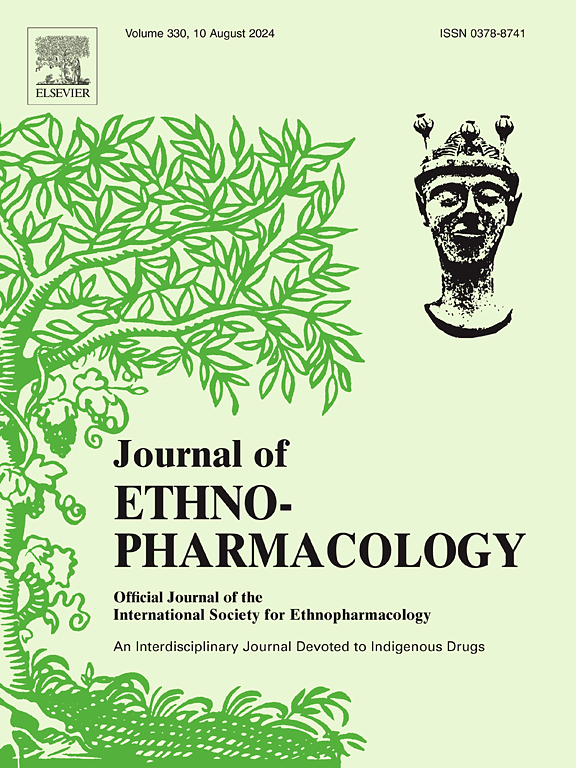檀香:从传统功效到药理学性质和现代治疗应用。
IF 4.8
2区 医学
Q1 CHEMISTRY, MEDICINAL
引用次数: 0
摘要
民族药理学相关性:桑檀木(Santali Albi Lignum, SA)是桑檀木(Santalum album L.)树干的干心材,最初发现于印度。它在阿育吠陀和中医中有着悠久的使用历史,主要用于治疗皮肤、心血管和肺部疾病。近年来,SA因其具有抗肿瘤、神经保护和胃肠调节等多种药理作用而受到广泛关注。目的:从民族药理学、植物化学成分、药理作用、质量控制及临床应用等方面系统综述了白藜芦醇的研究进展;并对该草药进一步研究开发的方向进行了讨论。方法:SA的信息主要来源于出版资料、中医经典古籍和电子数据库(PubMed、谷歌Scholar、Science Direct、Web of Science China National Knowledge Infrastructure和中医典籍)。结果:在SA中共鉴定出216个分子,包括萜类、有机酸类、酚类、醛类、烷烃类、酯类、酮类、类固醇类、醇类、木脂素类等化合物,其中倍半萜类已成为主要生物活性成分。SA提取物或化合物具有广泛的生物活性,包括神经保护、抗肿瘤、抗炎、抗氧化和胃肠道作用,已在体外和体内药理学研究中得到证实。通过α⁃桑他洛尔、β⁃桑他洛尔和挥发油的定量鉴定来监控质量。含有SA的中药制剂常用于治疗冠心病、心力衰竭、缺血性中风、皮肤病等。结论:本系统综述表明,现代生物活性和临床研究报告为SA的疗效提供了科学依据,特别是具有活气止痛的能力。目前的研究主要集中在白杨挥发油部分的化学成分和药理作用上。此外,SA的活性化合物和提取物的综合药理机制仍需要全面阐明。进一步加强对其毒理学和药代动力学的研究,确保其临床合理、安全使用。本文章由计算机程序翻译,如有差异,请以英文原文为准。
Santali Albi Lignum: From traditional efficacies to pharmacological properties and modern therapeutic applications
Ethnopharmacological relevance
Santali Albi Lignum (SA), the dry heartwood of the trunk of Santalum album L., was originally discovered in India. It has a long history of use in Ayurveda and traditional Chinese medicine (TCM), mainly to treat skin, cardiovascular and lung diseases. In recent years, SA has received worldwide attention because of its diverse pharmacological effects, including anti-tumour, neuroprotective and gastrointestinal regulatory effects.
Purpose
This paper aims to systematically review progress in the research on SA, focusing on its ethnopharmacology, phytochemical ingredients, pharmacological effects, quality control and clinical applications; directions for further research and development of this herbal medicine are also discussed.
Methods
Information on SA was obtained mainly from published materials, classic ancient books on TCM and electronic databases (PubMed, Google Scholar, Science Direct, Web of Science China National Knowledge Infrastructure and traditional Chinese medicine classics).
Results
A total of 216 molecules have been identified in SA, including terpenoids, fatty acids, organic acids, phenols, aldehydes, alkanes, esters, ketones, steroids, alcohols, phenylpropanoids and other compounds, of which sesquiterpenes have emerged as the primary bioactive ingredients. A wide spectrum of biological activities of extracts or compounds of SA, including neuroprotective, antitumour, anti-inflammatory, antioxidant and gastrointestinal effects, have been verified in in vitro and in vivo pharmacological studies. Quality is monitored by the quantification and identification of α⁃santalol, β⁃santalol and volatile oils. TCM formulations that contain SA are commonly used to treat coronary heart disease, heart failure, ischaemic stroke, skin diseases and others.
Conclusions
This systematic review demonstrates that modern bioactivities and clinical research reports provide scientific evidence for the efficacy of SA, especially the ability to circulate qi and alleviate pain. Current studies have focused mainly on the chemical composition and pharmacological effects of the volatile oil fraction of SA. Moreover, the integrated pharmacological mechanisms of the active compounds and extracts of SA still need to be comprehensively elucidated. Furthermore, research on its toxicology and pharmacokinetics should be expanded to ensure the reasonable and safe clinical use of SA.
求助全文
通过发布文献求助,成功后即可免费获取论文全文。
去求助
来源期刊

Journal of ethnopharmacology
医学-全科医学与补充医学
CiteScore
10.30
自引率
5.60%
发文量
967
审稿时长
77 days
期刊介绍:
The Journal of Ethnopharmacology is dedicated to the exchange of information and understandings about people''s use of plants, fungi, animals, microorganisms and minerals and their biological and pharmacological effects based on the principles established through international conventions. Early people confronted with illness and disease, discovered a wealth of useful therapeutic agents in the plant and animal kingdoms. The empirical knowledge of these medicinal substances and their toxic potential was passed on by oral tradition and sometimes recorded in herbals and other texts on materia medica. Many valuable drugs of today (e.g., atropine, ephedrine, tubocurarine, digoxin, reserpine) came into use through the study of indigenous remedies. Chemists continue to use plant-derived drugs (e.g., morphine, taxol, physostigmine, quinidine, emetine) as prototypes in their attempts to develop more effective and less toxic medicinals.
 求助内容:
求助内容: 应助结果提醒方式:
应助结果提醒方式:


